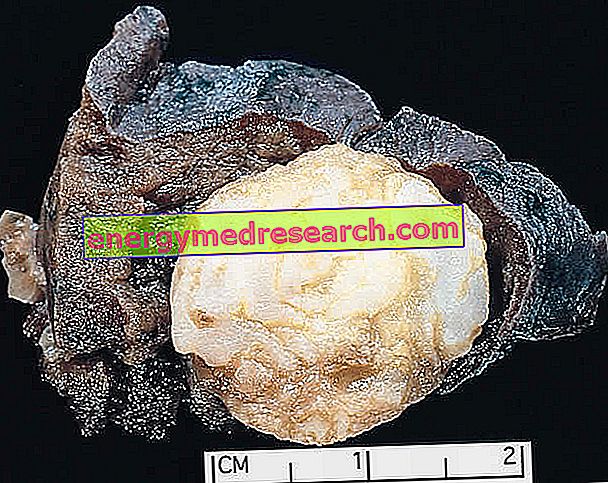Generality
Hamartomas are a special type of tumor-like lesion .
These neoformations are characterized by an aberrant proliferation of cells and tissues, which are normally found at that particular site of the body; however, these elements grow in a disorganized way.

Large parenchymal hamartoma of the lung; its yellowish white appearance is due to its adipose and cartilaginous composition. Image from en.wikipedia.org
The nature of hamartomas is benign (non-cancerous) and, in most cases, does not evolve in a malicious way. These lesions develop at the same rate as the surrounding tissues and remain localized in the areas of the body in which they arise.
Hamartomas can be asymptomatic or give rise to compression symptoms, deformities or major health problems. If they cause functional disorders or are unsightly, these masses can be surgically removed.
What's this
Hamartomas are focal hyperplastic formations, that is they derive from an abnormal proliferation of cells and tissues, confined to the place of origin.
Unlike benign neoplasms, these lesions have a complete structural similarity with respect to the tissue to which they belong (ie they are formed by cells and native tissues of the organ in which they are located).
For example, a pulmonary hamartoma may contain: cartilaginous tissue, drafts of bronchi and alveoli, islands of lymphatic and vascular tissue or a prevalence of one of these components.
Hamartomas can form in many different parts of the body, but they are mainly observed in the lungs, liver, bile ducts and nervous system.
Usually, hamartomas are asymptomatic and go unnoticed, unless they are found during tests performed for other reasons.
In some cases, however, these lesions are bulky and cause compression symptoms.
Causes
At the base of the hamartomas, there is an aberrant differentiation, from which result disorganized but specialized cells or tissues originating in the specific onset district. The reasons for these phenomena have not yet been fully understood.
Hamartomas grow as a disorganized mass, together and at the same rate as the surrounding tissue and the organ from which the lesion originates; unlike cancerous tumors, they rarely invade or significantly compress the surrounding structures.
Traditionally, hamartomas are considered the result of a defect in the normal development process . However, many of these lesions present clonal chromosomal aberrations acquired through somatic mutations (similar to what occurs in neoplasms).
Hamartoma vs benign neoplasia
- The dividing line between hamartoma and benign neoplasia is thin and there is no unanimous consensus about their distinction, as both lesions can be clonal.
- Hemangiomas, lymphangiomas, cardiac rhabdomyomas and hepatic adenomas are considered hamartomas by some medical-scientific sources, while they are classified among neoplasias by others.
- Although hamartomas have a benign histology, they are not harmless. In fact, these lesions can be related to some rare but life-threatening clinical problems, as can occur in type I neurofibromatosis and tuberous sclerosis. Sometimes, then, the hamartoma can develop into a malignant neoplasm.
The tendency to develop hamartomas can be observed in the context of specific conditions, including:
- Hamartomatous intestinal polyps;
- Peutz-Jeghers syndrome (hamartomatous polyposis, which involves the entire digestive tract);
- Pulmonary or bronchial amartoma and chondroma;
- Neurofibromatosis type 1 (NF1) or von Recklinghausen disease;
- Neuroepithelial hamartoma in tuberous sclerosis;
- Bone hamartomas;
- Hamartomas of the hypothalamus and of the ashy tuber (a region consisting of gray matter that protrudes between the optic chiasm and the mammillary bodies, to which the pituitary is suspended by means of a peduncle).
Hamartomas vs coristomas
Hamartomas must be distinguished from coristomas. These two lesions are closely related (both are considered aberrations of the development process of a given organ), but they present a substantial difference:
- Hamartomas consist of tissue elements normally found there;
- Coristomas are small masses of normal cells and tissues but located in an anomalous anatomical site (that is, normally, they are not found in the context of a particular organ; for example: pancreatic tissue in the duodenum).
Symptoms, signs and complications
Small hamartomas are usually asymptomatic, so they do not cause any problems and are discovered accidentally during investigations carried out for other purposes.
Rarely, these lesions are bulky and cause compression symptoms.
In the latter case, hamartomas can cause some of these problems:
- Obstruction of hollow organs of the body, such as the stomach or colon;
- Pressure, direct or indirect;
- Infection;
- Heart attack;
- Hemorrhage;
- Iron deficiency anemia;
- Fracture;
- Neoplastic transformation.
In other cases, hamartomas can cause complications due to their position. For example, when they develop on the skin, especially on the face or neck, they can cause deformities and be unsightly. Furthermore, hamartomas can compress veins and nerves and, if larger, also arteries.
These lesions cause more health problems when they arise in the hypothalamus, kidney or spleen.
Hypothalamic hamartoma
A hypothalamic hamartoma is a benign lesion that develops in the brain.
Unlike many hamartomas, this hypothalamic lesion is symptomatic. The manifestations generally begin at an early age and are progressive; over time, this condition can lead to general cognitive and / or functional disabilities.
Hamartomas located in the hypothalamic area can be found if the etiology of precocious puberty has been investigated or, on the contrary, it can be stopped.
The formations can also determine the appearance of a particular type of epilepsy, in which laughter (form of motor automatism) represent the main convulsive manifestation. During these crises, facial contractions, hot flushes, increased breathing and tachycardia are combined.
From a hypothalamic hamartoma, other conditions can arise, such as visual problems, mental retardation, autism and poor social skills.
Due to the proximity of the lesion to the optic nerve, this formation cannot usually be removed by surgery. Furthermore, hypothalamic hamartomas tend to be refractory to drug treatment.
Fortunately, surgical techniques are making progress and can lead to a significant improvement in the prognosis of this disease.
Cardiac hamartoma
Rhabdomyomas of the heart are hamartomas composed of cardiomyocytes. These formations are found in the pediatric age and can be associated with tuberous sclerosis.
These hamartomas can manifest with a wide spectrum of clinical manifestations, ranging from the absence of symptoms to heart failure.
Echocardiography is the most sensitive and specific tool for the diagnosis of this pathology.
These intracardiac masses frequently undergo spontaneous regression within the first year of life. If the hamartoma should increase in volume or cause significant disturbances, surgery is recommended. In symptomatic patients, resection is related to a good prognosis.
Pulmonary hamartoma
The most common hamartomas occur in the lungs. They almost always develop from connective tissue and are generally made up of cartilage, connective tissue and fat cells, although they can include many other types of elements.
About 5-8% of all solitary pulmonary nodules and about 75% of all benign lung cancers are hamartomas.
Here, hamartomas can be a cause for concern, as it is sometimes difficult to distinguish between these lesions and a malignant tumor. The treatment involves surgical resection, with an excellent prognosis.
Spleen hamartomas and blood vessels
- Hamartomas that occur in blood vessels can predispose to severe bleeding. The lesion typically lacks elastic tissue, so it can lead to the formation of aneurysms. If the development of the hamartoma involves an important blood vessel, such as the renal artery, the bleeding must be considered life-threatening.
- Spleen hamartomas are rare, but can be dangerous. About 50% of these cases show abdominal pain and are often associated with haematological abnormalities and spontaneous rupture.
Diagnosis
- A correct diagnostic classification is of fundamental importance to establish a timely and effective treatment.
- Given that the differential diagnosis between hamartomas and neoplasia is clinically impossible, the lesions are often surgically removed and subjected to anatomo-pathological examination.
- If surgical management is considered, further investigations are necessary, such as laboratory analyzes, radiographs and other imaging studies.
Treatment
Treatment of hamartomas depends on the patient's signs and symptoms at the time of clinical presentation.
If necessary, these formations can be surgically removed, with different approaches (radiosurgery, thermocoagulation, resective microsurgery etc.). Once removed, hamartomas do not tend to recur.
Indications for surgery
Surgical removal of a hamartoma can be indicated:
- In case of clinical doubt or if a biopsy is needed to distinguish between benign and malignant lesions;
- When the patient becomes symptomatic and the mass compresses the surrounding structures or interferes with the normal functions of the organ or tissue in which it is located.
Prognosis
The prognosis depends on the location and size of the lesion, as well as on the patient's overall health. Depending on the type of hamartoma and the risk of evolution in the malignant sense, the follow-up may include visits at a half-yearly or annual frequency.



